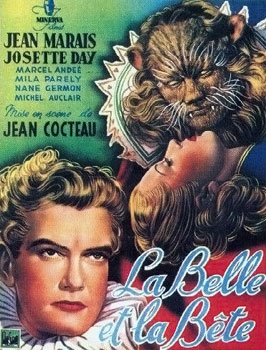This month, for my blind spot pick, I wanted to tie the film I watched into a film that’s going to be released in the cinema this month and considering that this month sees the release of the live action remake of Disney’s Beauty and the Beast, I thought it fitting to go back to the other most famous adaptation of the story, Jean Cocteau’s La Belle et la Bete. Now, before I watched it, my main experience with the film came from the 3 part review by Kyle Kallgren and Tony Goldmark (aka Some Jerk With A Camera) and reading some of the stuff Guillermo Del Toro wrote about it (after watching it’s completely obvious why Del Toro was inspired by it) so I didn’t really have the strong background that I know other people have had with this film, most of my knowledge of the story comes from the Disney film. I have to say though that, in many ways, this version is better than the Disney version.
I don’t think I need to go over the plot of the story, as said in the Disney version, it’s a tale as old as time so I think everyone knows the basics. What I want to talk about here is the way that the story is framed. From the first scene of the film, there’s this embracement of fairy tale logic that provides a great sense of charm throughout the film. Every action in the film needs to be seen through this lens of fairy tale logic, which Cocteau makes sure you know right up front. This logic mainly applies to the characters and the rather broad characteristics they have (with the exception of the Beast, which I’ll get into later). Belle is portrayed as really humble, wanting to see the Beauty in the world, her sisters are the stereotypical evil sisters, wanting only material possessions and the image of luxury, Belle’s brother is an idiot who ruins the family with his poor finances and Belle’s dad is good hearted, loving and honourable, being fully willing to be killed by the Beast for theft rather than let one of his daughters take his place. The story is a simple one, but brilliantly told and framed perfectly.
The performances in the film help it stand out amongst the adaptations of the original story. Jean Marais gives one of the best performances I’ve seen as the Beast and Avenant, Belle’s human suitor and the most likely inspiration for Gaston in the Disney version. As the Beast, Marais shows the Beastly nature brilliantly with there being a lot of self-loathing and isolationism in the character. Every second he stays as the Beast is torture for him, sometimes literally when he succumbs to his beastly nature and hunts deer.As Avenant meanwhile, Marais shows the arrogance and violence of the character, along with the pride he has in his actions. Through both the writing of the characters and having Marais play both the Beast and Avenant, the metaphor regarding the beastly natures of the characters is made more effectively here than it was in the Disney version. As Belle meanwhile, Josette Day gives a more subdued performance, more reactive to everything around her when she enters the castle but this more subdued style of performance works for the humble nature of Belle and as such it feels more natural when Belle falls in love with the Beast.
On a technical level the film is just incredible, especially for 1946. The design of the Beast’s castle is gorgeous, a timeless quality being seen throughout, creating this grand, imposing structure that adds to the intimidation first felt when encountering the Beast. The use of human features in the design meanwhile adds to the feel of magic in the castle, mainly the statues that look around and the handelabras. The make-up for the Beast meanwhile is excellent, aided by the strong costume design. The design of the make-up really highlights Jean Marais’ eyes and all the pain they are filled with, whilst the costume design whilst the costume design does a great job mixing the make-up for the Beast with an elegant style of wardrobe that further highlights the self loathing that the Beast has and his disgust with his beastly form. There’s also some excellent trick photography in the film, very impressive for 1946, related to the Beast’s magic, the highlight being when one of Belle’s sisters grabs Belle’s pearl necklace, which turns into weeds, throwing it down, the weeds turning back into the pearls in one shot, just a brilliant piece of filmmaking.
Overall, it’s easy to see why La Belle et la Bete has had the strong impact in fantasy that it’s had. The simplicity of the story has helped it endure throughout the years whilst highlighting all the aspects that make the film work so well, mainly the incredible production design and make-up and the strong performances from Josette Day and especially Jean Marais. I don’t know whether I prefer this version or the Disney version, there are some elements that one does better than the other (this version has a better Beast, castle and human suitor for Belle in the form of Avenant whilst the Disney version has a better Belle and environment outside the castle) but I can say that this is an excellent version of the story in its own right.
My Rating: 4.5/5

After seeing The Disney version several times growing up. I am curious to check out this version. It’s cool that you note that this one has a better beast. It’s cool that the same actor played the role of The Beast and of Belle’s Snoby Suitor
LikeLike
I’ve seen many versions of this story: Disney’s animated, Disney’s live action and recent French take on this (with Vincent Cassell and Lea Seydoux), and I’ve been eager to watch Cocteau’s version but my resource is so limited.
LikeLike